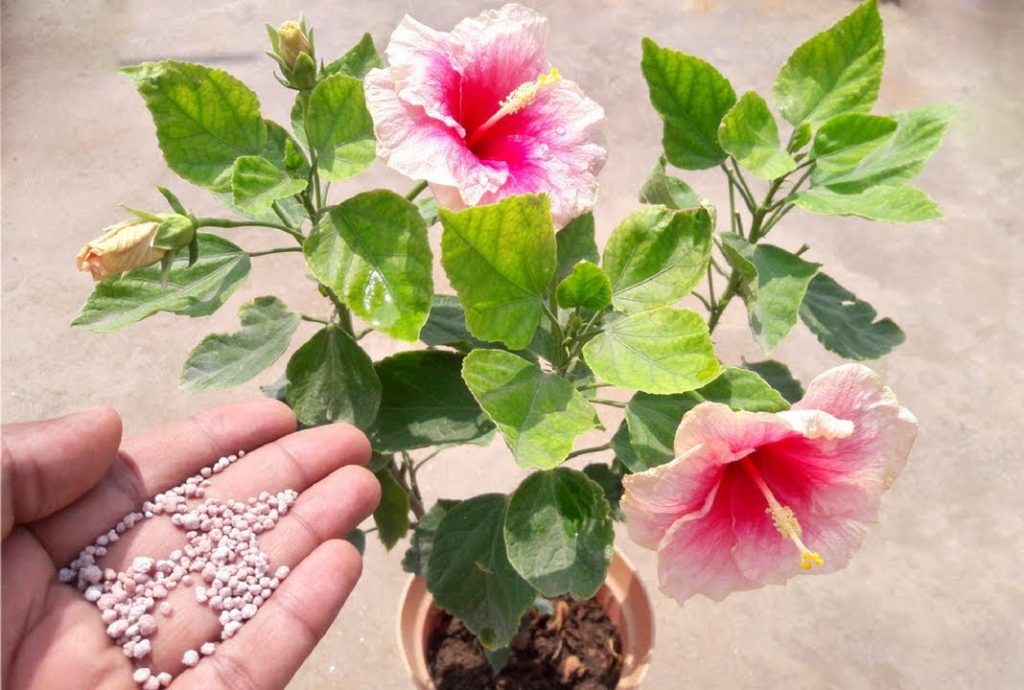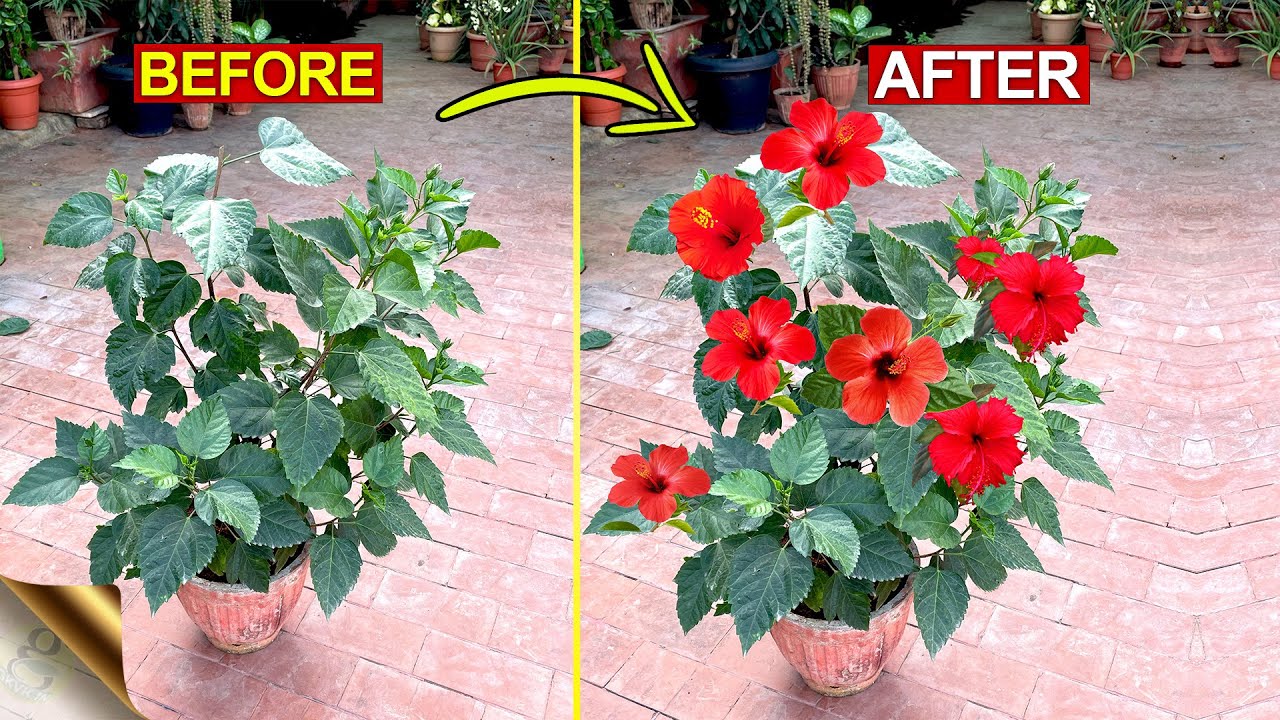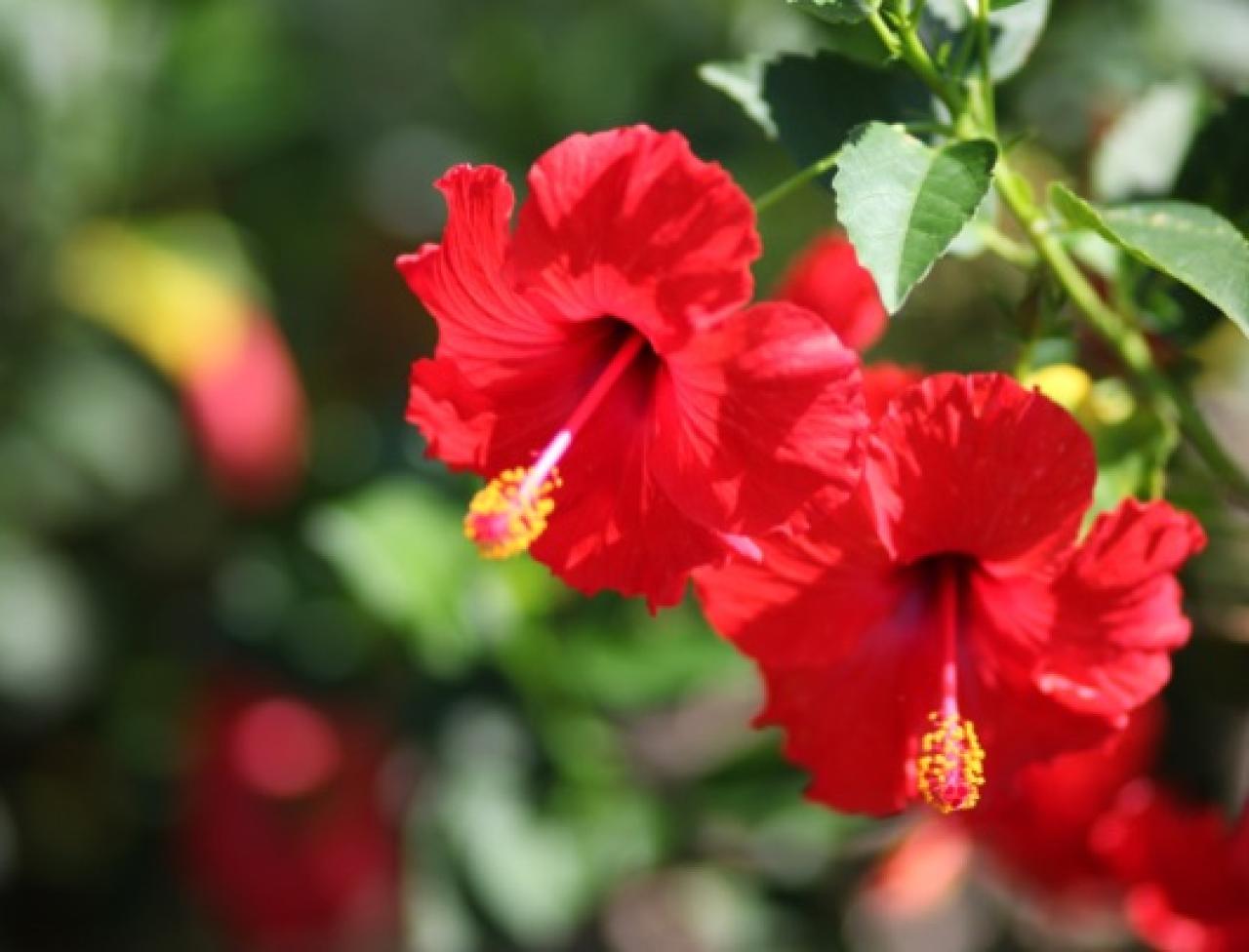
If you want more hibiscus flowers, put it in full sun and give it lots of water in the spring while the flower buds are growing. Always prune hibiscus in the early spring to encourage new growth and more blooms because hibiscus only produces blossoms on fresh growth.
Read on to discover the six most crucial ways to produce more hibiscus blossoms and make sure the blooms stay as long as possible.
Table of Contents
1. Use The Correct Fertilizer For More Flowers (Avoid ‘Blooms Boosters’)
Hibiscus are somewhat uncommon plants in that they are quite sensitive to excessive phosphorus levels in the soil, which can both prevent the hibiscus from flowering and have a negative impact on the hibiscus’ general health.
Garden soils that are naturally abundant in phosphorous to the extent that a hibiscus would be noticeably harmed are uncommon.
The use of “bloom booster” fertilizers, however, can generate high levels of phosphorus, which are paradoxically counterproductive in the case of flowering hibiscus because the excess phosphorous makes it harder for the hibiscus to absorb other nutrients.
Avoid using these types of fertilizer anywhere near your hibiscus plants because tomato feeds also include more phosphorus than typical fertilizer to encourage the development of fruit.
Use a well-balanced fertilizer with equal amounts NPK to produce more hibiscus flowers and prolong the bloom period (Nitrogen, Phosphorus and Potassium).
The phosphorus level of the fertilizer will not be a concern in terms of preventing blooms if it is balanced evenly. Although they do require some phosphorus, hibiscus cannot withstand excessive amounts of the nutrient.
All the nutrients the hibiscus requires are present in fertilizers like miracle-gro all-purpose fertilizer at the proper dosage to stimulate flowering.
As opposed to liquid fertilizers, which can wash away in heavy rain, I personally prefer granular fertilizers because they release the nutrients gradually throughout the length of the peak flowering season to nourish the blooms for longer.
Hibiscus leaves turning yellow and the plant dying may be caused by high quantities of phosphorus in the soil. Read my post on how to revive a dying hibiscus for the remedy if your plant appears to be in poor health.
2. Prune Hibiscus in the Early Spring For More Flowers
Hibiscus bloom on new growth, thus the secret to encouraging blossoms is to softly prune the plant in the early spring (March or April), since this helps to encourage new growth from which the flowers are exhibited ready for the peak.
The peak of flowering, which should occur in the summer, may occur too close to fall or winter if pruning is done too late in the growing season (in late spring or summer). This might cause flowering to be delayed by several weeks. The flower buds may drop before blossoming in the Fall because to the decreasing temperature.
Hibiscus respond well to mild pruning, which removes any lanky growth and maintains an attractive shape, to increase flowering. To promote new growth that can produce additional flowers, prune any growth that is an inch or so above a node.
Ideally, a branch should still have a number of nodes that are capable of sprouting new growth and, consequently, more blooms.
Hibiscus can be pruned in late summer or the fall, but neither of these times stimulates new growth from which flowers are produced as much as a mild pruning in the early spring.
3. Consistently Moist Soil Promotes More Hibiscus Blooms

Due to their deep roots, some established hibiscus plants rarely require additional water, but for smaller hibiscus, hibiscus that have just been planted, or hibiscus that are grown in pots, it is ideal to make sure the soil is evenly moist, especially in the spring.
The hibiscus flower buds form in the early spring, and if the soil dries up at this time, the buds may drop off or fail to open as a result of drought stress.
Apply a generous layer of mulch around the base of your hibiscus at the beginning of spring to help keep the soil moist and prevent the sun from baking the soil dry and evaporating the moisture from around the hibiscus’s root system. This will help prevent the buds from falling off and increase the display of flowers.
A layer of mulch made of compost or leaf mold manure is a wonderful choice because it should not only keep the soil moist but also give the hibiscus more nutrients and promote soil ecology.
In the height of Summer, mulch keeps the hibiscus roots cold, which fosters the ideal circumstances for producing the most flowers.
To prolong the life of the flowers, water the hibiscus generously, ideally before any drought is predicted.
One of the causes of the yellowing of hibiscus leaves is drought stress. Why are my hibiscus leaves becoming yellow? Read my post to find out. learn about the hibiscus’ additional justifications and how to protect it.
4. Avoid Nitrogen Fertilizer to Promote More Flowers
As nitrogen encourages development at the expense of blooms, a hibiscus plant with an abundance of luxuriant foliage but few flowers typically suggests a high quantity of nitrogen in the soil.
Excess nitrogen is typically caused by using liquid fertilizers too regularly, supplementing the garden with manure, or runoff from lawn fertilizer, which is particularly high in nitrogen (chicken manure in particular is high in nitrogen).
Lawn fertilizers easily disintegrate in rain, can run off into garden borders, and have an impact on plants like hibiscus by inhibiting flowering.
Avoid using manure as a mulch around your hibiscus; instead, use compost or leaf mold. Be careful when using lawn fertilizer. Use granular fertilizer instead of liquid fertilizer to nourish your flowers.
5. Hibiscus Flower More in Full Sun
Making ensuring the hibiscus is in full light is the most crucial step in boosting the amount of flowers it produces.
Hibiscus rosa-sinensis and other hibiscus species grow more profusely in full sun, though they can also bloom in filtered or partial shade.
More sunlight can also aid in maintaining the ideal daytime temperature range of 65°F to 75°F, which is necessary for the bud-forming process.
If required, move your hibiscus to a position with more sunlight in the early spring or late fall. Trim back any trees or bushes that shade your hibiscus.
The hibiscus has a chance to establish itself and absorb water if it is transplanted in the spring or fall rather than during the stifling summer heat.
But I should point out that in really hot areas, the hibiscus frequently blooms better with six hours of morning sun followed by an afternoon in the shade.
This is so that the hibiscus can benefit from the sun in the morning, when the temperature is significantly lower.
When the hibiscus is exposed to intense afternoon sunlight and sweltering heat, this can stress the plant by increasing soil evaporation and leaf transpiration, which can lead to drought stress and prevent the flower buds from opening.
In that scenario, make sure to frequently water your hibiscus and to surround the base of the plant with a layer of mulch to retain moisture.
Consider growing hibiscus in pots if your area is particularly hot so you can move them out of the sun if necessary if they start to exhibit signs of drought stress (wilting leaves and buds not opening).
6. Increase the Number of Blooms On Potted Hibiscus

Put the hibiscus in the biggest pot you can manage.
The ideal conditions for the hibiscus to blossom are created by larger pots since they have more potting soil capacity, which increases their ability to hold moisture and nutrients.
In smaller containers, hibiscus roots may become pot-bound, experience drought stress, or use up all the nutrients in the soil.
Being able to move the pot easily to a location with more sunlight, which is the most crucial element for increasing the number of hibiscus flowers, is one of the best things about growing hibiscus in pots.
For potted hibiscus to produce a good display of flowers, fertilize them often in the spring and summer as they have less access to nutrients than hibiscus planted in garden soil (miracle-gro all purpose granular fertilizer is a great choice).
Read my post, Why is my hibiscus not blooming, if you can’t figure out why your hibiscus isn’t flowering. for the solution.
Key Takeaways:
- Planting the hibiscus in full light is the most crucial step in maximizing the quantity of blooms and the life of the flowers on the plant. Hibiscus receives extra energy from the sun to encourage blossoming.
- As the flower buds emerge in the spring, keep the soil continually moist to enhance the quantity of hibiscus flowers. To encourage the growth of flower buds and prolong the duration of the hibiscus bloom show, water your plants liberally and mulch the soil.
- To boost the amount of hibiscus blossoms, trim the hibiscus in the early spring to encourage further growth. Hibiscus only produces flowers from new growth. Later season pruning might cause blossoming to be delayed and can result in fewer blooms.
FAQ
Is Epsom salt good for hibiscus?
For hibiscus plants grown in the ground in locations with neutral or acidic soil, or for plants grown in pots where the water drains out the bottom rather than being repeatedly drawn back up into the pot, Epsom salts are a good choice.
How do I get my hibiscus to bloom more?
At planting time and during the growing season, water plants thoroughly. Use Miracle-Gro® Water Soluble Bloom Booster® Flower Food to feed your plants. To promote the greatest blooms, hibiscus should be deadheaded and pruned. In the majority of zones, bring tropical hibiscus inside throughout the winter.
How do you fertilize hibiscus?
Combine balanced organic or slow-release granular fertilizer with liquid fertilizer with high N and K levels. Distribute the granular plant food over the top of the soil. Soak the root zone in the liquid before application.
What fertilizer is best for hibiscus?
Plants that grow hibiscus rely mostly on N and K, while using much less P. A fertilizer with an analysis like 10-10-10 will provide a balanced startup feeding at planting time and every year as fresh growth starts in the spring. Select a plant meal with a fertilizer analysis like 12-4-8 or 17-5-24 for routine feeding.
How do you use Epsom salt on hibiscus?
Apply 1 tablespoon of Epsom salts per gallon of pot size, or once a month, scatter a good amount of them around grounded plants. You can soak the soil in the water-soluble fertilizer or spray the leaves with it after adding epsom salts.
